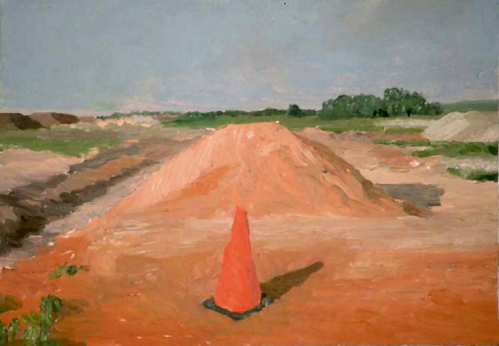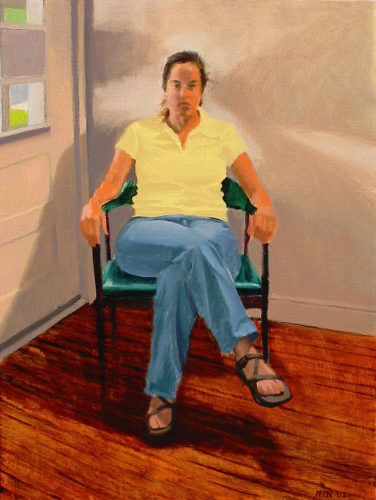Perceptual Painting Theory and Practice
by Noel Robbins
( ed. note… Painting Perceptions give many thanks to Noel Robbins for sharing these brilliant notes on perceptual painting which were originally written for his students in Texas.)
In order to make believable paintings of our visual experiences we have to translate them into a language of painting focused on visual experience. Painting perceptually means painting masses of colors and edge qualities as they appear to the eye. Seeing subjects figuratively has to be suppressed in order to paint conditions of light and space; we have to interpret the people, places and things we see as masses of color.
Details are not important. Well observed color relationships are what make paintings feel believable and real, not details. No amount of careful detail work will ever give a painting the qualities of a unified visual experience if the painting does not have well related colors. Let go of the desire for detail. Instead, condition your eyes to appreciate how a few carefully related colors can create a world within the picture plane. Study great paintings with this in mind.
Squint at the subject. The more we squint, the more the image in our eyes is reduced to essential color masses.
Determine the overall qualities of light, space and form by looking indirectly at the subject. Glance at it, squint, look at it in a dirty mirror, a curved mirror, think about the dark colors while looking at the lights, think about the light colors while looking at the darks, think about the whole effect on your senses while looking away from the subject. Is there a color quality to the place? What is the tonal range? How much can you simplify the color masses and edges and still capture the visual impression of your senses?
Start with your favorite color, relate your second favorite color to the first, then the third to the second, and repeat until the whole composition is blocked in.
Look for the similarities. If you see multiple parts of your subject as similar in value or color, then group them as one color and make the difference later.
Do not draw outlines; a few quick notations of related points in space will give all the compositional structure needed to start massing in the fundamental colors. Reduce the subject to the fewest number of color masses possible. Use measuring and mapping techniques to determine the placement of the center of each color mass.
Paint from the center of color masses out to their edges. Do not paint outlines or contours and then fill them with color. Paint from the center out to find edges and where one color meets another.
If a color inside an object is similar to a color in the background next to it, lose any edge between them and group them as one color.
Start with transparent oil color and paint simple masses. Scrape, scrub, and wipe to achieve desired colors and edge qualities. Use more paint to get darker colors and less for lighter colors.
From the great painting teacher Charles Hawthorne: “Let the eye go from one spot to another without the aid of outlines. Jump from the center of one spot of color to the center of the next. Keep your eye away from the edge a little more – don’t insist that the eye shall stop at the edges. Mechanically lose them by rubbing the palette knife though them…. Don’t paint up to a line, work from a center; don’t fill in an outline but make the inside form the outline.”
Once the essential color masses are blocked in add opaque paints to deal with particular qualities of space, atmosphere, light and form.
Transparent paint applications typically feel more textured and spatially aggressive, while opaque applications feel softer, more atmospheric and recessive. Look at paintings done by masters in museums and galleries – not in reproduction – to examine how they used transparent and opaque paint applications to achieve particular effects. The Blanton Museum has some good examples in their permanent collection.
One common approach to using transparent and opaque paint applications is to paint the light colors opaquely and thickly after painting the dark colors transparently and thinly. This can be reversed – opaque darks on top of transparent lights – to achieve different qualities.
Elaborate on the block in by adjusting color masses and edge qualities. Use all the tools available to you including brush handles, knife, fingers, Q-tips et al. to add, remove, and manipulate the paint as needed to achieve unified visual statements.
Lennart Anderson, another great painting teacher, said in an interview:
“You paint the quality of the place. The figure or objects or whatever your subject is comes out of the whole, not the reverse. You can’t get a whole, a unified composition, by painting the parts. The problem people run into is they try to pin down parts as they go, which ruins any chance of getting a unified composition.”
Perceptual paintings are not mere descriptions of what we see, and they do not serve narrative. They are artistic inventions made in response to sensory experience of the external world and the medium itself.
Let people find their own closure. People naturally make figurative images out of abstract masses of color, so it is not necessary to paint every detail; play with perception by leaving parts of your paintings unfinished. People feel a connection to images that they have to complete from their own memories. If you have captured the essential qualities of your visual experience then you can leave the painting as abstract as you like. In fact, it may be better to leave a particular painting in a more abstract state if by continuing to work on it you risk losing unity.
The method of direct painting (a.k.a. alla prima, premier coup) can be broken down into the following steps:
- Use the indirect seeing techniques described above to determine what your sensory responses are to the subject, and plan your composition.
- Lightly sketch in the major relationships of points in space, or go straight into color masses.
- Using transparent paint on white canvas mass in your favorite – the most prominent – color. Be careful mixing all your colors. Use the spot screen and value stick to help you achieve good colors. Identify the value, hue and intensity of each color you mix. By determining the value, hue and intensity of each color you will find mixing them much easier. In time mixing color will become more automatic, but for now get into the habit of slowing down and identifying the three basic characteristics of colors before mixing them. Use the palette knife to mix your colors. When applying the colors to the canvas refrain from massing them all the way out to their edges. You will more easily find edges and make connections between the masses as the painting develops. Hold back on the temptation to pin down the contours of the masses, and stay open to making changes.
- Relate the second most prominent color to the first with squinting and indirect seeing. Identify its characteristics, mix and mass it in.
- Mix and mass in the third most prominent color relating it to the other two while squinting and looking indirectly at the subject, using the spot screen and value stick, and identifying color characteristics.
- Repeat this process until all the essential colors are blocked in.
- Once all the color masses are blocked in use the indirect gaze and squinting at both the painting and the subject to figure out what kinds of changes need to be made to the colors to tune them to each other. Make these changes by scraping, wiping, mixing and applying fresh colors. Introduce white to your mixtures as opacity is needed. As you apply these mixtures begin pulling the masses together to find edges.
- Add color variations as distinct intervals of freshly mixed color. Wipe or blot where these color intervals will be massed. Keep the edges soft unless a more firm edge is needed for the composition. Reserve the hardest edges as finishing touches.
- Step back and look indirectly at both the painting and subject at the same time. Take a ten minute break. Repeat indirect gazing at both subject and painting. Look at them in a mirror if possible. Make adjustments to colors, masses and edges with capturing the unified visual experience that you had when you first looked at the subject as your goal.
- Add any details and hard edges at this time. If these hinder the unity of the composition then delete or change them.
- Hang your painting at home where it is readily visible. As time goes by it might speak to you asking for changes. Make those changes, but keep in mind that the ultimate goal is a unified composition.
Painting Perceptions greatly appreciates the generosity of Noel Robbins’ in sharing above notes on perceptual painting which were written for his students. Noel Robbins received his MFA and taught painting and drawing at The School of the Art Institute of Chicago in the mid-nineties and currently teaches at Southwestern University in Georgetown, Texas.









Hello.A great post which ive visited more than once.You know.ive just been squinting at areas of shadow,a few different things .each objects shadow darkens a bit when i squint and see no detail. My question is Is this darkened tone the actual colour note you would put down first…the color note of the shadow lightens and becomes more chromatic when i open my eyes….so would you put down the note you see when squinting ? Thank You.
Dear Mr. Dawson,
I apologize for this late response, and I’m glad you found my notes on PP helpful. To answer your question I would recommend squinting as you start to collect information on the value structure of your composition. After you have that in mind use the other observational techniques mentioned in the article to refine your understanding of the qualities unifying the whole; return to the Lennart Anderson video. Spend time just hanging out with the subject and your thoughts. You are painting your response to the subject, your subjectivity, not an objective reality, so get to know what’s happening in your head before you start mixing color. This will be your road map through the process of constructing your painting.
I hope that’s helpful. Let me know if you have more questions.
Best regards,
Noel
Hey Noel,
I’m a jerk who once took your drawing class at ACC Cypress Creek. I was looking for a website online where I could purchase one of your paintings – can you let me know where and how I can do that? I really loved your work.
Your website seems to be down.
Thanks – Jeff